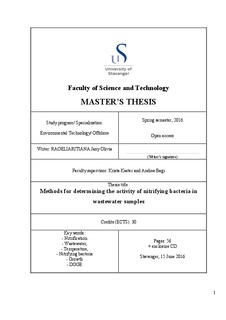Methods for determining the activity of nitrifying bacteria in wastewater samples
Master thesis
Permanent lenke
http://hdl.handle.net/11250/2410675Utgivelsesdato
2016-06-15Metadata
Vis full innførselSamlinger
Sammendrag
The present study investigated the feasibility of nitrification in wastewater and the community structure of nitrifying bacteria at two different temperatures, 10 and 25°C. The experiment was conducted in sequencing batch reactor (SBR). During this experiment, ammonia, nitrite and nitrate analysis were achieved to determine the potential nitrification. The community diversity of nitrifiers was explored by using a culture-based method: most probable number (MPN) and a molecular based method denaturing gradient gel electrophoresis (DGGE). We observed that nitrification occurred at both tested temperatures. The result of nitrification showed that the ammonia, nitrite and nitrate concentration were lower at 10°C compared to those incubated at 25°C. The nitrification rate showed also that there was a slight difference between the wastewater incubated at 10°C and 25°C, as the nitrification appeared to be faster at 25°C than at 10°C. The experimental results indicated that temperature is an important factor affecting the nitrification process. According to the MPN results, the abundance of the nitrifiers increased throughout the experiment. The MPN results also showed that the concentration of nitrifiers was higher at 25°C than at 10°C. Furthermore, the band patterns observed in the DGGE analysis revealed a shift in community composition over time and also showed that the day 60 (final) communities were different at 10°C compared to 25°C. The higher number of bands indicated that the bacterial diversity was higher at 25°C than at 10°C. To summarize this study, an effect of change in temperature has been observed during the nitrification process, which affect at the same time the change in bacterial diversity of nitrifying bacteria.
Beskrivelse
Master's thesis in Environmental technology
